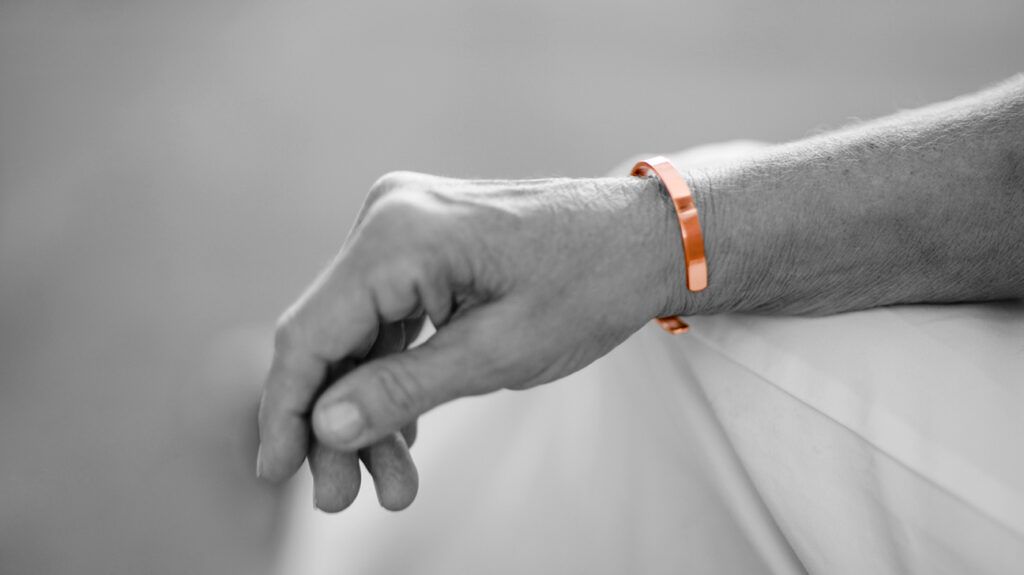Some people claim that copper bracelets help ease the aches and pains of arthritis. However, there is no strong evidence that they work. Studies indicate that they have no significant impact on symptoms.
Proponents of copper bracelets for arthritis say the skin can absorb tiny particles of copper, which then reduce inflammation of the joints.
There is evidence to support that the copper in foods may reduce inflammation in the body and is an essential nutrient for bone health. However, there is a lack of evidence supporting copper absorption from bracelets.
This article will examine whether copper bracelets help with arthritis, exploring what benefits they might have and why some people may report pain relief.

There is no strong evidence that copper bracelets help with arthritis. One of the most thorough studies to test them took place in
The researchers tested the potential benefits of both copper and magnetic bracelets for rheumatoid arthritis. The study included 70 participants and required them to try wearing four different bracelets. These included:
- a copper bracelet
- a standard magnetic wrist strap
- a weaker magnetic wrist strap
- a nonmagnetic wrist strap, as a control
Participants wore each bracelet for 5 weeks, with a 1-week break between each. The authors assessed the joints for pain and disability, ensuring that neither doctor nor patient could determine the type of bracelet they were wearing. This helped reduce the risk of bias.
If one of the bracelet types in the trial produced a minimum 20% improvement in tender and swollen joints, the scientists would have considered it clinically effective.
But there were no significant improvements in the self-reported symptoms for any of the bracelets while participants wore them. There was no improvement in pain, joint function, or inflammation.
Dr. Stewart Richmond, who led the 2013 study from the Department of Health Sciences at the University of York in the United Kingdom, said that “people who suffer with rheumatoid arthritis may be better off saving their money, or spending it on other complementary interventions, such as dietary fish oils, for example, which have far better evidence for effectiveness.”
This study is also the basis for the Arthritis Foundation’s advice against using copper bracelets as a treatment for arthritic inflammation.
The researchers in the
Believing that a placebo might help can, in itself, cause an improvement. This is known as the placebo effect. This real physical phenomenon could explain why some people report that copper bracelets help them. Placebos can still be
However, the way chronic illnesses can get worse and better over time could also play a role. Dr. Richmond explained that people may begin wearing the copper and magnetic bracelets “during a flare-up period.”
As inflammation and symptoms subside naturally over time, a patient may “confuse this with a therapeutic effect” that they believe is coming from the bracelet.
“Pain varies greatly over time in conditions like rheumatoid arthritis, and the way we perceive pain can be altered significantly by the power of the mind,” Dr. Richmond adds.
Legally, companies in the United States cannot make claims that their products directly treat any medical condition without evidence.
As there is no firm evidence supporting copper bracelets, sellers of these products may rely on vague or unrelated phrases to promote their product, such as:
- “worn for healing by mankind for centuries”
- “made from the finest pure copper”
- “the metal has a natural ability to conduct heat”
- “copper is essential for our bodies”
These statements sound impressive, and some of them are true. Copper does conduct heat, and as a nutrient, it is essential to the body.
But wearing a copper bracelet will only conduct a person’s existing body heat. Unless a person warms the bracelet up first, wearing it does not provide any additional heat therapy.
There is also no confirmation that people can absorb copper through the skin from a solid piece of jewelry. A study from the 1970s suggested that this may occur, as the copper bracelets that participants wore lost between 80 and 90 milligrams of copper over 50 days.
But the researchers did not confirm an increase in copper in the participants’ bodies. The lost copper could simply have worn away rather than crossing the skin barrier.
There are no known side effects of wearing copper bracelets. However, a person who buys one and finds it ineffective does risk losing money.
Additionally, people with metal allergies could have reactions to copper bracelets. This may cause contact dermatitis, which is a type of eczema.
Arthritis does not have a cure. Modern treatments can manage the pain and reduce inflammation, though. In the case of autoimmune diseases such as rheumatoid arthritis, treatment can also slow the course of the disease.
A treatment plan may involve:
- pain relieving techniques and coping methods
- medications
- lifestyle adjustments
- exercise and physical therapy
- surgery, in some cases
If a person does not mind purchasing a copper bracelet to see if it works for them, and they do not have a metal allergy, there may be no harm in trying it alongside other treatments.
However, copper bracelets are not a substitute for medical care. People should also tell their doctor if they are considering complementary or alternative treatments, as some can cause interactions with other conditions or drugs.
Learn more about remedies for arthritis.
There is no firm evidence to show that copper bracelets help with arthritis. Although some people report that they improve symptoms, a study from
That said, those who do find copper bracelets useful could be benefitting from the placebo effect. This is not necessarily a negative thing. In fact, some people may find it useful, so long as they experience no negative effects.
People who are experiencing significant pain or mobility issues due to arthritis can speak with a doctor for more advice on how to reduce symptoms. Always consult a doctor before trying complementary or alternative therapies.
